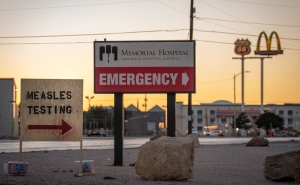Growing and Aging: The Population of People Living with HIV

Interview by Melissa Hartman
Antiretroviral therapy, or ART, has made it possible for people with HIV to suppress their viral load and live lives nearly as long as those without HIV. But aging with HIV brings an increased risk of other health conditions, including cancer, diabetes, and kidney disease. A new study projects the number of and ages of people on ART in the coming decade—and suggests that the U.S. health systems need to prepare to meet the needs of this growing and aging population.
In this Q&A, Keri Althoff, PhD ’08, MPH ’05, an associate professor in Epidemiology at the Bloomberg School and lead author of that study, explains how we’re currently meeting the needs of people with HIV, how those needs are changing, and what is needed in the future.
How are the health needs of people with HIV on ART different from those of people the same age who aren't HIV positive?
People who are aging with HIV have an increased burden of a number of age-related chronic conditions, including renal impairment, cardiovascular disease, cancer, end-stage liver disease, hypertension, and diabetes. This is due to both chronic immune activation from the viral infection as well as metabolic outcomes linked to some earlier versions of antiretroviral medications.
In addition, persons with HIV have a higher prevalence of traditional risk factors for age-related conditions, the most prominent being a higher prevalence of smoking. A number of studies have shown that this conglomeration of factors has resulted in people with HIV having an increased burden of age-related diseases.
How is the U.S. health care system doing now in meeting the needs of this population?
Part of the reason we put this study together was to put some hard number estimates behind what we should anticipate in terms of this aging population of persons with HIV. The HIV care model that has been used very successfully in the United States usually has a person’s HIV home as their health care home. And that makes sense when you're in your 20s, 30s, and 40s and you may not yet be seeking care from an endocrinologist or a cardiologist, but you do need to see someone for your HIV. So you're being followed by an HIV clinician.
We have tried to meet this population where they are in those HIV care centers. A lot of HIV care is delivered out of clinics that have mental health services, renal services, and cardiology services. Those experts are in the HIV clinic at certain times, assisting individuals who are aging with HIV.
That sounds pretty great, actually.
It’s a pretty good model. But as people age successfully with HIV, HIV is typically not the most active condition. If you're taking your antivirals and your viral load is suppressed, it actually might be your renal disease or cardiovascular disease or diabetes that needs more attention. So the question is, can we morph this model a bit so that a primary care provider is the health care home for persons with HIV—and the HIV clinician is part of the expertise the same way a cardiologist provides their expertise? Will patients with HIV be amenable to this? Will HIV clinicians?
A recent study showed that the pipeline of professionals training in HIV care is shrinking. Our modeling study shows the population of persons with HIV is increasing because they're living longer with HIV. That’s a good thing—but setting up our systems to meet their health care needs is critical. And right now, we have a lot of long-term survivors with HIV. They have issues with mobility, cognitive function, and age-related comorbidities. They're struggling with their health and they need wraparound care. And they are just the beginning of a growing population that will need this.
Your study looked at different demographic groups within the population of people aging with HIV. Why was that important to do?
We have important heterogeneous subgroups in this population: For example, Black women, white men who have sex with men (MSM), and also a rising number of Hispanic individuals. We have populations whose HIV transmission risk is from injection drug use. We need to think through how care is tailored to each of these subgroups.
We know, for example, that individuals who have injected drugs have a higher risk of not only HIV but hepatitis C virus infection and subsequent liver disease. So we need to think through, what is the age distribution of persons who have used injection drugs? And how will that impact our need to ensure that hepatologists are involved in care for these individuals as they age? Thankfully, we now have curative treatment for hepatitis C virus infection, but the longer-term consequences of this infection may still need medical attention.
Another important group is Black women. Black women with HIV have an increased burden of metabolic-related conditions. So thinking through the prevention and treatment interventions most successful for these women is key for many clinics who care for them.
How old are the people entering treatment, generally?
It's young adults, mainly under age 30. After the federal Ending the HIV Epidemic in the U.S. was announced in February 2019, amazing test-and-treat programs were rolled out, targeting the populations where we see the highest incidence of new HIV cases, which is among younger individuals.
Once an individual tests positive for HIV, 75% are successfully linked into HIV care within 30 days, according to our national HIV surveillance system data. That has been a tremendous success, and we need to continue those programs.
Who will use the findings from these studies, and how?
The federal agency that administers the Ryan White HIV/AIDS Program [which provides support for the care of people with HIV] and the state programs that support HIV care need to know how the population of people with HIV using ART will grow in the next decade so they can budget for care and think through how to best provide care for this growing population.
In addition, it is important for the National Institutes of Health to think about persons with HIV and the chronic conditions that are burdensome in people with HIV so that research into mechanisms and disease processes can be supported. For example, the National Cancer Institute may want to solicit research proposals for a specific type of cancer that is likely to increase in numbers in people with HIV as they continue to age, such as lung cancer.
And also, our study recognizes the people who are living with HIV at these older ages. Hopefully, our estimates of the size of the population at older ages speaks to those living this experience. We want them to hear us say, “We see you, and you're not forgotten.” In discussions with older persons with HIV, I have found that some feel forgotten or overlooked. So our study findings are a recognition of these older adults with HIV, and the middle-age adults with HIV that will survive into older age in the next decade.
What’s next for your research in this area?
Our next step with this model is to look at the probability of age-related diseases occurring in persons with HIV. We’ll project the burden of multiple chronic conditions like hypertension, diabetes, chronic kidney disease, and cancer, as well as multimorbidity. From all the preliminary data we've run, it is a big burden: Most persons who are older with HIV will have three or more additional conditions.
We're trying to see what that burden looks like so we can not only prepare systems to care for those persons, but also rethink this critical time where people come in and get linked into HIV care. Is that an important time for weight management programs? Is this an important time for smoking cessation programs? How much downstream disease could we prevent? That’s what we're thinking about now: How do we prevent comorbidity as people age with HIV?
Melissa Hartman is the managing editor of Hopkins Bloomberg Public Health magazine and associate director of editorial at the Johns Hopkins Bloomberg School of Public Health.





